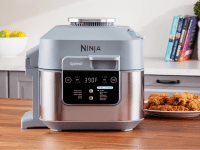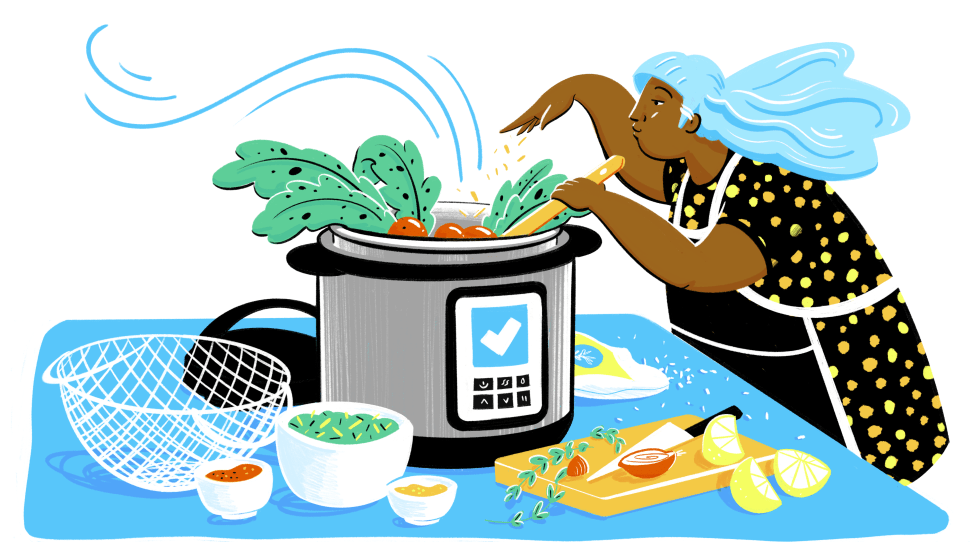 Credit:
Reviewed / Tara Jacoby
Credit:
Reviewed / Tara Jacoby
Recommendations are independently chosen by Reviewed's editors. Purchases made through the links below may earn us and our publishing partners a commission. Prices were accurate at the time this article was published but may change over time.
In recent years, pressure cookers from the likes of Instant Pot and Ninja have taken over food-related headlines as a must-have appliance for the home kitchen. Whether you’re still a little skeptical about the supposed magic of pressure cooking, or just purchased one of these appliances, here’s a handy guide on how to set yourself up for success.
Full disclosure: As the author of Mastering the Instant Pot, I must admit I’m just a little biased when it comes to pressure cooking. I think it’s such an incredible multipurpose tool! Pressure cookers allow you to extract flavor from economical cuts of meat, reduce the prep and cook time for weeknight dinners, heat up frozen items in a flash, and even sterilize equipment for the kitchen. Below, you’ll find some tried-and-true tips and tricks to get comfortable with pressure cooking, fast.
Choosing the right pressure cooker for you
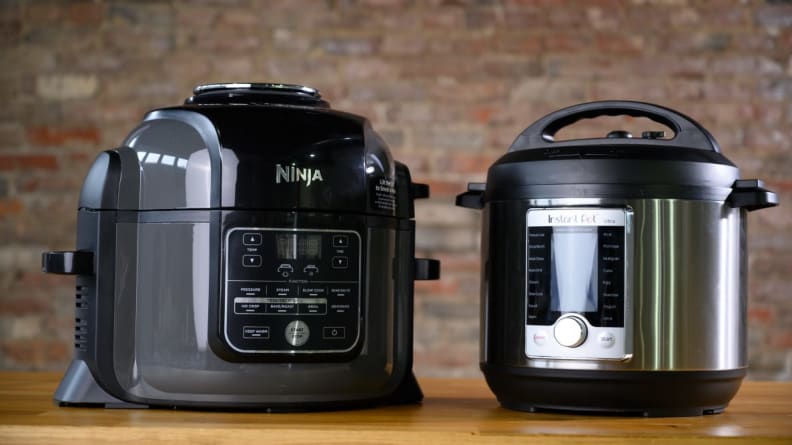
Instant Pot Ultra and Ninja Foodi are two of the best pressure cookers we've tested.
There are tons of pressure cookers now on the market, with varying sizes as well as functionalities. And even if you’ve picked a brand, there can be many options to choose from (like the seemingly endless Instant Pot models). Here are some important considerations when buying your first pressure cooker:
Size: How many people do you typically cook for?
In situations where the primary cooking is for one person, a 3- to 4-quart model is a great choice for making staples that last for one or two meals. For couples or small families with greater cooking requirements and a little more space, a 6-quart (generally the top-selling size) is perfect for a group meal, or for weekly meal prep. For larger families, or those who host gatherings often, an 8-quart pressure cooker can be utilized for big batches of food, or even a whole turkey for Thanksgiving.
Functionality: What do you anticipate using your pressure cooker for?
One of the main points of differentiation for pressure cookers on the market are the different functions each is equipped with. While basic models will almost always offer settings like Slow Cook, Sauté, Steam, and Keep Warm in addition to the main Pressure Cook function, fancier models offer everything from a special Yogurt cycle to Air Fry and Sous Vide.
If you already own a variety of other appliances and don’t anticipate needing to repurpose your pressure cooker for more than, well, pressure cooking, opt for a simpler model. Alternatively, if you are hoping to utilize your pressure cooker for a wide range of duties in the kitchen, perhaps it’s worth the splurge for one with the most available settings (like the Ninja Foodi or Instant Pot Duo Crisp). However, remember that the pressure cooker is a pressure cooker first, and additional settings come second; it’s unrealistic to assume a pressure cooker with the sous vide setting will perform the same as a dedicated sous vide machine.
Price: What’s your budget for a pressure cooker?
Pressure cookers generally start around $100 and can increase dramatically from there. After thinking through your desired pressure cooker functions (this will likely influence the model you’ll choose), think about how frequently you anticipate using your pressure cooker. Is this something you believe will be a regular part of your weekly cooking routine, or a useful tool for special occasions? Does it make economic sense to choose the fancier model with more settings, or instead just buy a separate tool to achieve what the extra functions of a pressure cooker could?
Understanding what a pressure cooker does
Given that the Pressure Cook function is the main purpose of a pressure cooker, it's worth diving into some more technical detail here so you feel confident in utilizing the whole spectrum of its abilities. In short, pressure cooking is the process of cooking food using some amount of liquid inside an appliance with an airtight seal. Because of this seal, the pressure inside the chamber containing the ingredients can amount to what is above the regular atmospheric pressure of the Earth.
This is very important, because this first allows the liquid inside to boil at a temperature above the standard boiling point of pure water, 212°F (100°C). When the resulting steam from water boiling is trapped in the pressure cooker and cannot evaporate, it turns back and pushes against the water, causing it to reach a higher boiling temperature.
Pressure cookers have set pressure levels, and when that limit is reached the appliance will automatically let out enough steam and lower its heat source to maintain the proper pressure inside the chamber so the temperature does not continue rising. This additional pressure is measured in units of pounds per square inch (psi) in the U.S. At 15 psi, pure water boils at 250°F (121°C), which is why using pressure cookers can dramatically cut down on the amount of time needed to cook certain ingredients.
Additionally, pressure cookers are very useful for those of us who live in places of high altitude (over 3,000 feet or 915 meters above sea level). Rather confusingly, higher elevations result in lower atmospheric pressure—meaning that at higher elevation, water boils at a lower temperature than the standard 212°F (100°C). This causes many boiled foods, such as rice, to be undercooked without the use of a pressure cooker. The general rule-of-thumb is to add 5% more time for every 1,000 feet your area is above 2,000 feet above sea level.
Tips and tricks for pressure cooker success
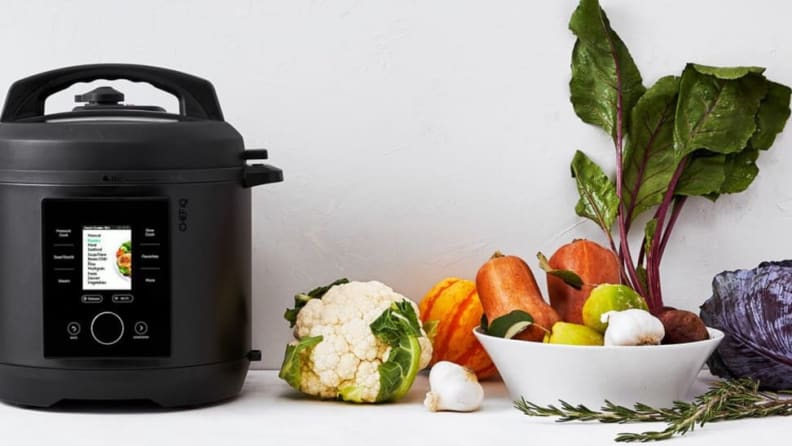
Pressure cookers like the Chef iQ allow you to monitor your cooking using an app on your smart phone.
Timing
The biggest learning curve for new users of pressure cookers is properly planning for the full length of time required to cook a specific food. Although the item itself may need to only cook 30 minutes, the pressure cooker still requires time to adequately build up pressure—typically at least 5 to 10 minutes.
If you're using the natural release function (which allows the pressure cooker return to equilibrium naturally, due to outside pressure), factor in another 10 to 15 minutes once the cook time has is finished. Overall, a general rule of thumb is to add 20 to 30 minutes of time when planning to cook with the pressure cooker.
Choosing the right things to cook.
All pressure cookers require some sort of liquid to work properly. Whether the ingredients being cooked are partially or fully submerged in the liquid, or not submerged (think: steaming), it's important to understand that the pressure cooker is a moisture-forward appliance.
When thinking of what to cook in a pressure cooker, opt for items you would typically cook with liquid via boiling, poaching, braising, or stewing. Collagen-rich meat cuts, large cuts of meat on the bone, hard grains, legumes, etc. are all excellent contenders. Conversely, recognize that the pressure cooker does work somewhat aggressively—so delicate, raw ingredients are generally not good choices!
Getting comfortable with recipe conversions.
Generally speaking, pressure cooker functionality speeds up the cooking process for most items anywhere from 2x to 10x, usually landing around 4x. For example, a 3-pound whole chicken typically takes two or more hours to cook in the oven at 400°F, but can cook in a pressure cooker in 30 minutes!
It’s also important to note that when scaling up recipes during pressure cooking, you may not need to correspondingly increase your cook time. For example, cooking two 3-pound whole chickens would take the same time as just one, but require more liquid and take longer for the pressure cooker to build initial pressure.
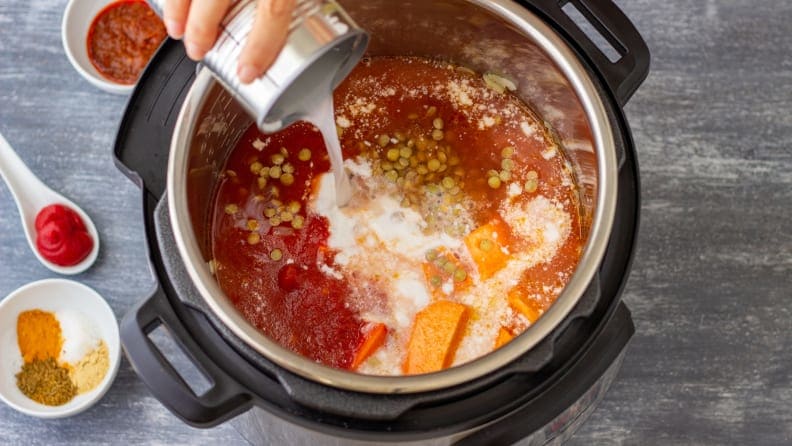
Start simple with your pressure cooker recipes; try chicken broth, rice, or chili.
Getting started: Step-By-Step
Step 1:
Pick a few simple recipes you want to try with your new pressure cooker—we recommend the Instant Pot or Ninja Foodi. I recommend starting with recipes like chicken broth, white rice, hard boiled eggs, oatmeal, and chili. These basic recipes will allow you to become comfortable with the different cook functions, observe how pressure cooking impacts the food as it cooks, and gauge how much liquid to use and the proper seasoning to add.
Step 2:
Do a test run with just water in your pressure cooker to practice working with the pressure release valve. Simply add one cup of water to the chamber, cook on High Pressure for two minutes, then use the Quick Release.
Step 3:
Record your cook time preferences. Everyone has different ideals for a braised chicken thigh, a pot of mac and cheese, or stewed beans. As you test out different pressure cooker recipes, make sure to write down what you liked (and what you didn’t) so you can reference in the future.
Step 4:
Start adapting your favorite staples for the pressure cooker! With a simple Google search, you’ll be able to find ways to make everything from imitation Starbucks egg bites to risotto and corned beef. Formulating ways to incorporate the pressure cooker to make your weekly to-do’s easier will make you happier and ensure you’re getting the most out of your pressure cooker.


